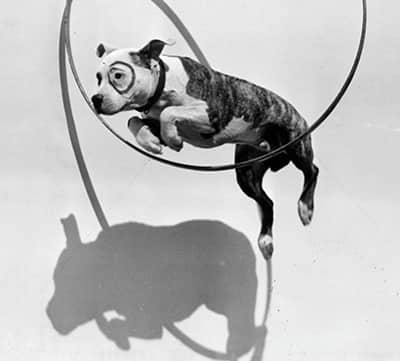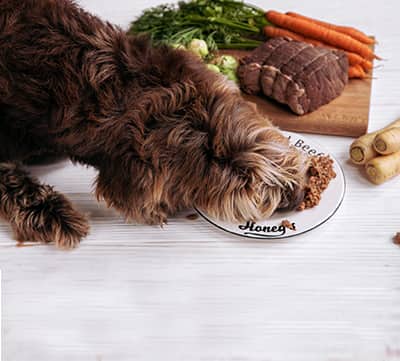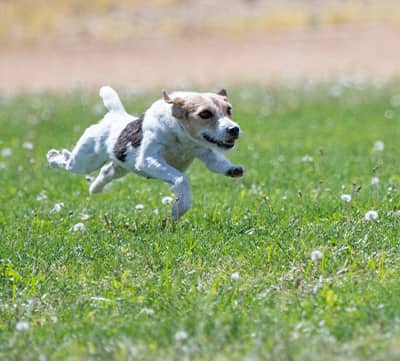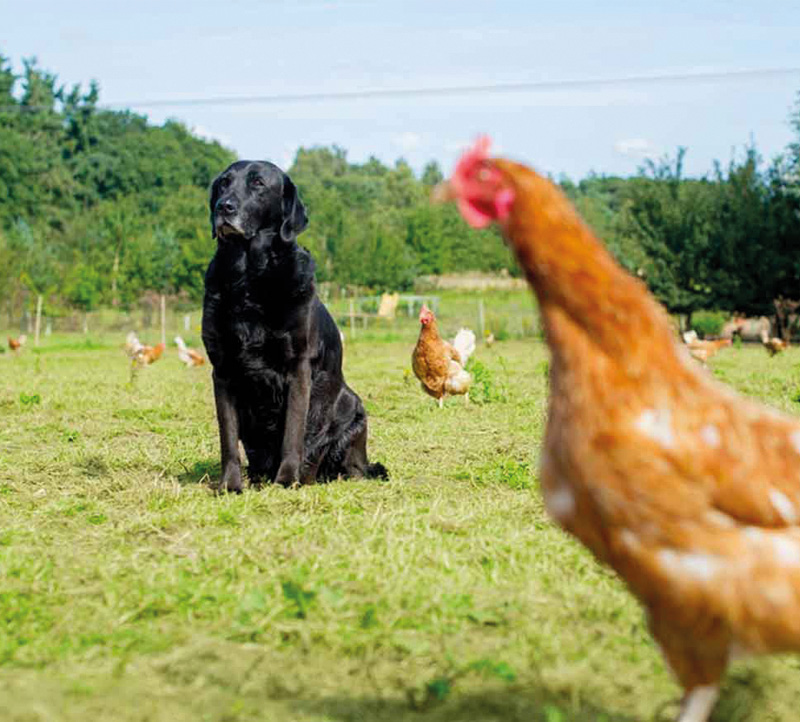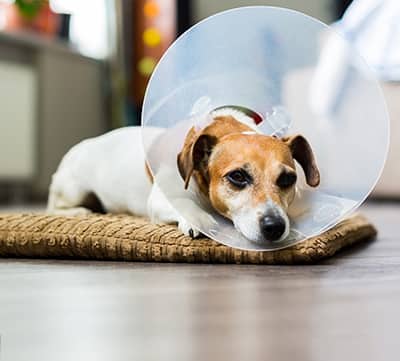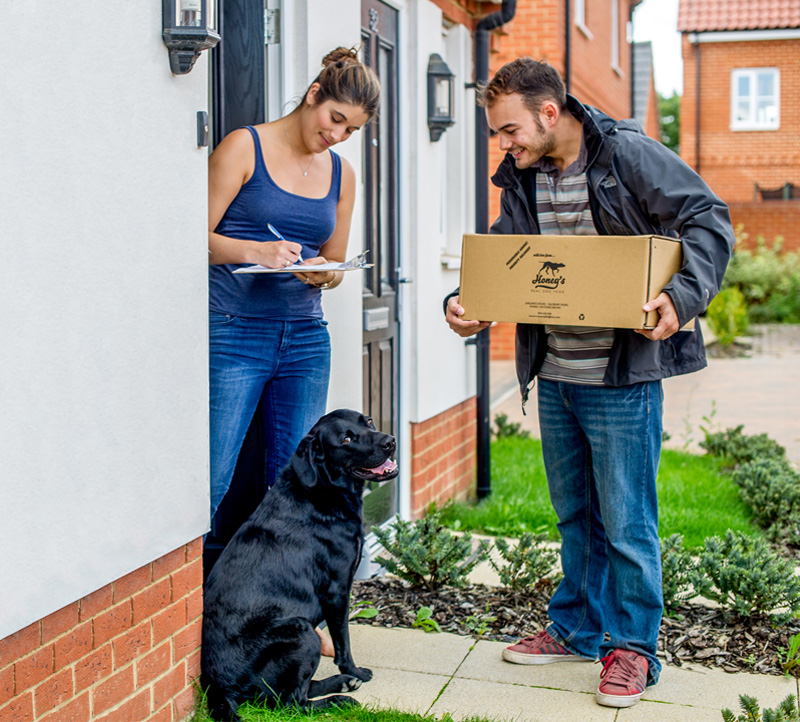More weight loss tips and tricks for dogs
The Lucky Dog Diet is, as you can see, absurdly simple and I am willing to guarantee its success if implemented correctly. Below are some of the little wriggles and short cuts I have discovered since I developed the diet, and some facts and other information you may find interesting.
A high moisture diet makes dogs happier
One of the things you’ll notice about the Lucky Dog Diet is that the food you serve will be quite moist. This is much healthier for your dog and will have the added advantage of making him or her feel fuller and less hungry. Why does moist food fill a dog up more? Think of the difference between potato crisps (high density, low moisture) and mashed potato (low density, high moisture). You have to eat a lot of crisps to feel full, but much less mashed potato. This is due to the relative moisture content.
Exercise made easy
There is absolutely no doubt that exercise plays a key role in weight loss. It is possible for your dog to reach his or her target weight without increasing the amount of exercise taken, but it will slow the whole process down. Moreover, exercise brings with it huge health benefits. It will strengthen your dog’s cardiovascular system and reduce his or her chances of suffering from a range of diseases. Dogs that exercise regularly are happier, too. Here are a few tips:
- Increase the amount of exercise gradually. Your dog will need to adjust to the change in regime.
- If your dog is obese, take it slowly. You don’t want to put extra strain on his or her joints.
- If your dog has a short nose (Pugs, Pekinese &c.) don’t allow them to get out of breath as their systems can’t handle strenuous exercise.
- Exercise comes in many forms – be creative.
- Generally, for a healthy dog, I would recommend an hour a day of vigorous exercise. It is more beneficial if the dog becomes out of breath, since this means his or her cardiovascular system is being exercised.
There are dozens of different and interesting ways to exercise your dog that will make it more fun for them and you. Here are some different ideas:
- Play fetch! Use a tennis ball, frisbee or other toy.
- Treat yourself to one of those snazzy tennis ball launchers.
- Join a flyball club (not suitable for obese dogs).
- Join an agility club (not suitable for obese dogs).
- Make your dog work for every treat (and be mean with the size of reward you give). For example, make him or her go up and down stairs a few times before handing over the reward.
- Swimming is great exercise. There’s the sea, rivers and lakes, of course. But also dedicated hydrotherapy and aquatic centres just for dogs.
- Join any sort of training club. Even basic obedience training will burn up the calories.
- Even getting on and off furniture or in and out of a dog bed uses up calories.
Please note it is not advisable to exercise a dog just before or after a meal.
Think big! Make the food up in batches and freeze it
All the food you will be serving as part of the Lucky Dog Diet can be frozen. So, if you would rather not have to shop for your dog every few days, why not make larger batches of the food up, divide it into appropriately sized portions and freeze it?
When I do this I form the food into patties (a bit like hamburger patties) and use plastic sheets to keep them separate in the freezer. You could equally well portion the food into plastic bags, containers or moulds.
Incidentally, bones can be frozen as well. Also, you should never thaw food in a microwave.
Note: there is no health risk associated with freezing food, thawing or partly thawing it, and then freezing it again. This is because modern domestic freezers are so efficient that they bring the food down to minus 18 degrees, or more – quite cold enough to stop most dangerous bacteria from forming. What does happen is that food repeatedly frozen and thawed becomes increasingly mushy and bloody.
The Lucky Dog Diet promotes the right sort of weight loss
Some research done by one of the processed food manufacturers proved that a high protein diet resulted in fat weight loss rather than muscle weight loss. If food contained 20% protein then 34% of the weight loss was muscle and 66% fat. But by increasing the protein level to 39% the muscle weight loss dropped to 14% and the fat weight loss increased to 86%.
Water, water, everywhere…
Tap water can contain trace elements of all sorts of contaminants including chlorine, fluoride, arsenic, toxic pesticide residues, heavy metals and so forth. This is not good for humans and definitely not good for dogs. Filtering the water helps. You could also consider rainwater and/or artesian spring water, which tends to be the cleanest and to contain the best range of valuable trace minerals.
Please don’t support intensive farming
For the most part farm animals lead short, painful lives in appalling conditions. They are kept indoors, in tiny cages, mutilated and transported hundreds and even thousands of miles before being killed. Furthermore, the way they are slaughtered is invariably drawn out and cruel. The photographs and imagery used by farmers, producers, food manufacturers, butchers, marketing boards and supermarkets create, by and large, an entirely false impression. Only a tiny percentage of farm animals lead relatively happy and natural existences. Unless the meat you buy meets certain criteria, the chances are that it has been intensively reared. To buy it is to support cruelty to animals. Of course, it is cheaper than meat from compassionately farmed animals: having a conscience does cost a little bit extra. But if you love animals, it is money well spent. What’s more, intensively reared meat is much more likely to be packed with harmful chemicals since intensively farmed animals are given many more drugs to keep them alive.
To ensure that the meat you are buying has not been intensively reared insist that:
- Chicken, pork and turkey are free range.
- Rabbit and venison are free range or wild.
- Lamb and beef have been grass fed or are free range.
- If you are buying organic meat, providing it is properly certified, you can be confident that it has been reared with animal welfare in mind.
It is much better for the environment and less wasteful to buy British. It is insane to buy lamb from, say, New Zealand when we have our own here at home. Also, beware of labelling. Ridiculous EU rules allow businesses to buy chickens in, say, Thailand but by cunning means describe them as being British.
If you would like to learn more about intensive farming, you might like to contact: Compassion in World Farming (www.ciwf.org.uk), which was started by an ordinary British farmer; the (World Animal Protection), a leading pressure group; and/or the (Soil Association), the UK’s leading campaigner for higher standards of animal welfare.
The fishy thing about fish
Some experts suggest you incorporate fish into your dog’s diet because, in the wild, wolves are, apparently, always holding their paws out to demonstrate how big their catch was and also telling stories about the one that got away. However, there are various issues surrounding fish as an ingredient. For starters, as it were, overfishing is a massive issue and very few species are unaffected. Then there is the fact that a high percentage of fish contain heavy metals such as mercury and other poisons. In fact, raw saltwater fish often disagrees with dogs. Finally, fish farming does terrible damage to the environment.
I rarely feed fish to my own dogs and we don’t sell any fish through Honey’s. If you decide to make fish one of the ingredients you feed your dog I would urge you to make sure it comes from a sustainable supply.
A word of warning about kibble…
Kibble can cause special health issues. Because it is so dry (5% to 10% moisture compared to 70% moisture in a natural diet) and so concentrated, it fails to stimulate the dog’s gastrointestinal system. Because of this, it can be dangerous to feed a dog until it feels full. Instead, one must keep the dog constantly hungry.
Don’t let your dog train you
Instead of giving your dog a food reward when they do something cute or for some other reason, try praise: it’s just as effective and contains no calories!
Keep a food diary
A food diary is really useful because it allows you (and your vet, if necessary) to understand how diet is affecting your dog’s weight. All you have to do is write down what you feed your dog every day. You could also include a note about how much exercise he or she gets. Involve everyone in the family. If someone slips the dog something forbidden then please, please remember to record it.
It is all a matter of scale(s)
Please remember to weigh your dog weekly as your dog’s weight determines how much food he or she receives every day.
The pros and cons of green tripe
If there were only one ingredient you could feed your dog, it would have to be green tripe. Nothing else offers such a variety of digestible proteins and your dog would thrive if fed nothing else (although it would still need raw bones, of course). What is green tripe? The dictionary defines it as: ‘the raw, unbleached stomach of cattle or other ruminants, after no other treatment than a simple rinse in cold water’. It has a green, fluorescent shine to it, although in colour it tends to be anything from light brown to black. From a dog’s perspective it is almost a wonder food, but from a human’s perspective it has a couple of potential drawbacks. To begin with, it contains a great deal of bacteria, some of which may be harmful to humans (but not dogs). For this reason, it can’t be kept in the same fridge or freezer as food for human consumption. It must be handled and served carefully so that no contamination occurs. If you have any cuts or grazes on your skin you shouldn’t touch it as it can lead to infection. Then there is the smell. This is not only strong but also lingers. It’s not a bad smell when you get used to it, but it’s a devil to wash off and so it really is best to handle tripe using rubber gloves.
In short, it is a nuisance to deal with but well worth the effort if you can be bothered, especially as it is relatively inexpensive. One final point, bleached tripe is worse than useless as the bleaching process strips out most of the goodness and leaves a potentially harmful chemical residue. Tripe that has been washed in plain water is not as good as green tripe but a less bothersome alternative and can be handled like other meat.
Reassurance about parasites
The major dog food manufacturers clearly feel threatened by the natural feeding movement and there is definitely a campaign to discredit raw feeding. As part of this campaign it is sometimes suggested that there are dangerous parasites in raw meat. This is incorrect. One of the reasons why you don’t have to be afraid of ‘killer’ parasites in a ‘prey’ animal being transferred to a ‘predator’ is that if this happened all predators would have become extinct long ago! Wolves simply wouldn’t have survived. Also, one has to remember that, in the wild, carnivores frequently target sick and old animals as they are easier to catch and kill. So, not only is it safe for wolves to eat raw meat, but it is safe for them to eat raw meat from poorly prey. Another reason not to be concerned is the acidity in a wolf’s (or dog’s) stomach. This is so strong that few organisms can survive exposure. The parasites that survive on a herbivore are, by and large, very different from the parasites that attack carnivores. There is one exception to this: tapeworm. These can be caught from fleas found on rabbits; so, if a dog eats a whole rabbit (as opposed to rabbit meat), there is a risk. This won’t affect you, though, unless you are giving your dog whole rabbit carcasses. Incidentally, there is a prejudice against pork, because in the distant past pigs used to carry a parasite called trichinosis. This parasite was eradicated in farmed pork in the UK (and Europe) in the 1960s. If you are still nervous about parasites (which I don’t think you need to be) freeze the meat down for an extended period.
A word about hygiene
Dogs may have stomach acids so strong that they would burn your fingers, but humans don’t. Raw food does have bacteria on it that could cause health issues for humans. Keep it separate from the food you are going to eat, thoroughly wash any surface it comes into contact with (including utensils, storage containers and so forth) as well as your hands. Use an anti-bacterial soap or mild disinfectant and/or wear rubber gloves. If you don’t want to use harmful chemicals, vinegar is a natural alternative.
Feeding on the move
The Lucky Dog Diet can pose a bit of a challenge when you are away from home. If you don’t have access to a freezer, the best option is to take the food frozen and to keep it as cold as possible. It doesn’t actually matter if the meat is a little smelly when served (your dog won’t mind!) but after a few days the vegetable element will start to lose its nutritional value. Still, with careful management food should last for up to eight or even nine days in a fridge.
Look at Kong, the Eighth Wonder of the World
This is one of my favourite lines from the 1933 movie King Kong. What does it have to do with your dog’s weight loss programme? Put a little of his or her food in a Kong (those rubber toy things with holes in them). It will take him or her hours to get the food out, and in the meantime they have been provided with mental stimulation plus they will have used up some calories in the process. Working on a Kong is quite tiring for a dog and they are more likely to settle afterwards, rather than hanging around the kitchen in a hopeful manner. Make sure the Kong is an appropriate size for the dog. If you have a dog who is brilliant at getting out the food, make it a bit harder by freezing the Kong after stuffing and giving him or her a Kongsicle! (Take it out of the freezer 10–15 minutes earlier.)
Vicky Marshall
Author of the Lucky Dog Weight Loss Plan
For more information and advice on any aspect of canine health and nutrition please contact Honey’s – we’ll be happy to help even if you never, ever plan to become a customer.
Web: www.honeysrealdogfood.com
Email: info@honeysrealdogfood.com
Telephone: 01672 620 260
